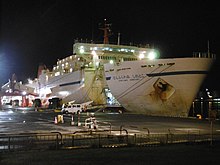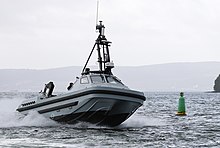
Back مسيرة بحرية Arabic Hladinové plavidlo bez posádky Czech Unbemanntes Wasserfahrzeug German Μη επανδρωμένο σκάφος επιφανείας Greek Vehículo de superficie no tripulado Spanish وسائل سطحی بدون سرنشین Persian Drone de surface naval French כלי שיט בלתי מאויש HE Imbarcazione a pilotaggio remoto Italian Kenderaan permukaan tanpa pemandu Malay
| Unmanned surface vehicle |
|---|
 |
| Topics |
| Related topics |



An unmanned surface vehicle, unmanned surface vessel or uncrewed surface vessel (USV),[2][3] colloquially called a drone boat, drone ship[4] or sea drone, is a boat or ship that operates on the surface of the water without a crew.[5] USVs operate with various levels of autonomy, from remote control[6] to fully autonomous surface vehicles (ASV).[7]
- ^ "MOL and Partners Set World Records for Time and Distance in Autonomous Navigation with Sea Trial Using Large Commercial Car Ferry - Follows Successful Trial of Coastal Containership in Autonomous Sailing -". Mitsui O.S.K. Lines. Archived from the original on 2022-02-08. Retrieved 2022-02-10.
- ^ "Uncrewed Surface Vessel Research and Development Program at the NOAA – UNH Joint Hydrographic Center/Center for Coastal and Ocean Mapping" (PDF). Archived (PDF) from the original on 2022-01-22. Retrieved 2021-07-14.
- ^ Patterson, Ruth G.; Lawson, Emily; Udyawer, Vinay; Brassington, Gary B.; Groom, Rachel A.; Campbell, Hamish A. (2022). "Uncrewed Surface Vessel Technological Diffusion Depends on Cross-Sectoral Investment in Open-Ocean Archetypes: A Systematic Review of USV Applications and Drivers". Frontiers in Marine Science. 8. doi:10.3389/fmars.2021.736984. ISSN 2296-7745.
- ^ Mizokami, Kyle (15 January 2019). "The U.S. Navy's Big Push Into Drone Ships Will Lead to Unmanned Vessels Carrying Weapons". Popular Mechanics. Archived from the original on 19 September 2020. Retrieved 19 August 2020.
- ^ Yan, Ru-jian; Pang, Shuo; Sun, Han-bing; Pang, Yong-jie (2010). "Development and missions of unmanned surface vehicle". Journal of Marine Science and Application. 9 (4): 451–457. Bibcode:2010JMSA....9..451Y. doi:10.1007/s11804-010-1033-2. S2CID 109174151.
- ^ "SM200 Wireless Remote-Helm Control System". Sea Machines. 11 December 2020. Archived from the original on 14 July 2021. Retrieved 14 July 2021.
- ^ Niu, Hanlin; Lu, Yu; Savvaris, Al; Tsourdos, Antonios (2018). "An energy-efficient path planning algorithm for unmanned surface vehicles". Ocean Engineering. 161: 308–321. Bibcode:2018OcEng.161..308N. doi:10.1016/j.oceaneng.2018.01.025. hdl:1826/13249. S2CID 115280769. Archived from the original on 2022-06-15. Retrieved 2021-10-19.